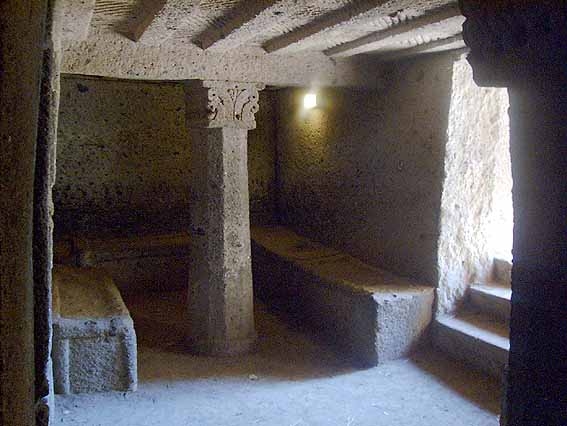The ancient Etruscan and Roman stood on the height called “La Civita“, behind the “hill of Monterozzi” where the town is located and where today is located the ancient necropolis (cemetery Monterozzi).
Religious Architecture
- Cathedral of Tarquinia;
- Santa Maria di Castello (1121-1208), where you can see influences from Lombardy and cosmateschi;
- Santissima Annunziata, where there are Arab and Byzantine influences;
- St. James;
- Church of the Intercession, an example of Baroque building;
- Church of San Pancrazio, where the Gothic style was grafted onto the Romanesque;
- Church of St. Francis;
- Church of St. John;
Civil architectures
- Medieval walls; preserves the current city, especially in the northern districts, a strong medieval character, accentuated by numerous towers of the walls, and several churches.
- Make the most characteristic scenery of the medieval city the remains of the Palazzo dei Priori, and some towers.
- The grand palace Vitelleschi started in 1436 and completed in elegant Renaissance to the 1480 to 1490, is home to the National Museum of Tarquinia.
Archaeological Sites
Etruscan city
The oldest evidence of settlement on the hill “La Civita” go back to a major urban center of the proto-Villanovan period (IX-VIII century BC) due to topographical studies could be calculated at around 150 hectares in size; there are not many remnants of the town, of which are visible in particular the impressive remains of a temple, now called Ara della Regina (44 × 25 m), dated around the IV – III century BC; the building, with single cell and colonnade was built in tuff with wooden superstructures and pottery decorations. It identified the route of the city walls, adapted to the altitude for a distance of about 8 km (IV – V century BC).
necropolis
An item of great archaeological interest consists of the vast necropolis, in particular the necropolis Monterozzi, which contain a large number of burial mounds with rooms carved into the rock, in which is preserved a remarkable series of paintings, which represent the most important collection pictorial came to us of Etruscan art and at the same time the most comprehensive document of all the ancient painting before the age of the Roman Empire. The burial chambers, modeled on the interior of the houses, the walls are decorated in fresh on a thin layer of plaster, with scenes depicting magical-religious funeral banquets, dancers, musicians of aulos, juggling, landscapes, in which is given a movement animated and harmonious portrait with rich, vivid colors. After the fifth century BC figures of demons and deities flank the farewell episodes, nell’accentuarsi the monstrous and pathetic.
Among the most interesting tombs include the tombs which are called the Warrior, Hunting and Fishing, the Lionesses, of Wishes, Jugglers, the Leopards, the festoons, the Baron, and Orc Shields. Part of the paintings, detached from some of the tombs in order to preserve them (the tomb of Chariots, the triclinium, the funeral bed and Ship), are kept in the National Museum Tarquiniense; others are visible directly on the wall on which they were made, giving us the knowledge of the disappearance Greek painting, which are linked by ties of kinship and dependence.
Of lower artistic level is the stone sculpture, reliefs present on plates or in the figure of the deceased lying on the sarcophagus; notable among others, the limestone sarcophagus of the tomb of Partunu, the work of fine workmanship, dating to the Hellenistic period; between the clay decorations, a high-relief fragment, from the pediment of the Ara della Regina, Tarquiniense is preserved in the National Museum, where the collection is among other things an important series of pottery, bronzes laminate, and terracotta reliefs from area, dating from the geometric period to the late Etruscan.
natural Areas
- Salina Nature Reserve of Tarquinia; are present in the territory of the old “Salt”, now a nature reserve of animal population of Saline di Tarquinia.

